人教版必修三第四单元教案
英语 人教必修版 第三册教案 Unit4
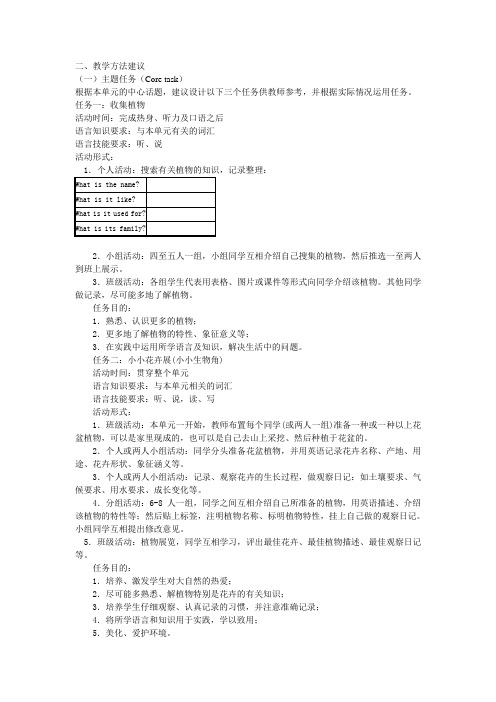
二、教学方法建议(一)主题任务(Core task)根据本单元的中心话题,建议设计以下三个任务供教师参考,并根据实际情况运用任务。
任务一:收集植物活动时间:完成热身、听力及口语之后语言知识要求:与本单元有关的词汇语言技能要求:听、说活动形式:1.个人活动:搜索有关植物的知识,记录整理:2.小组活动:四至五人一组,小组同学互相介绍自己搜集的植物,然后推选一至两人到班上展示。
3.班级活动:各组学生代表用表格、图片或课件等形式向同学介绍该植物。
其他同学做记录,尽可能多地了解植物。
任务目的:1.熟悉、认识更多的植物;2.更多地了解植物的特性、象征意义等;3.在实践中运用所学语言及知识,解决生活中的问题。
任务二:小小花卉展(小小生物角)活动时间:贯穿整个单元语言知识要求:与本单元相关的词汇语言技能要求:听、说,读、写活动形式:1.班级活动:本单元一开始,教师布置每个同学(或两人一组)准备一种或一种以上花盆植物,可以是家里现成的,也可以是自己去山上采挖、然后种植于花盆的。
2.个人或两人小组活动:同学分头准备花盆植物,并用英语记录花卉名称、产地、用途、花卉形状、象征涵义等。
3.个人或两人小组活动:记录、观察花卉的生长过程,做观察日记:如土壤要求、气候要求、用水要求、成长变化等。
4.分组活动:6-8人一组,同学之间互相介绍自己所准备的植物,用英语描述、介绍该植物的特性等;然后贴上标签,注明植物名称、标明植物特性,挂上自己做的观察日记。
小组同学互相提出修改意见。
5.班级活动:植物展览,同学互相学习,评出最佳花卉、最佳植物描述、最佳观察日记等。
任务目的:1.培养、激发学生对大自然的热爱;2.尽可能多熟悉、解植物特别是花卉的有关知识;3.培养学生仔细观察、认真记录的习惯,并注意准确记录;4.将所学语言和知识用于实践,学以致用;5.美化、爱护环境。
任务三:生物科学家论坛活动时间:学完“读前”、“阅读”、“读后”、“综合技能”之后语言知识要求:本单元有关词汇语言技能要求:读、写、说、听活动形式:1小组活动:以4-6人为一小组,讨论确定将要介绍的生物科学家。
人教新课标高中英语必修三Unit4Astronomy全单元详细教案
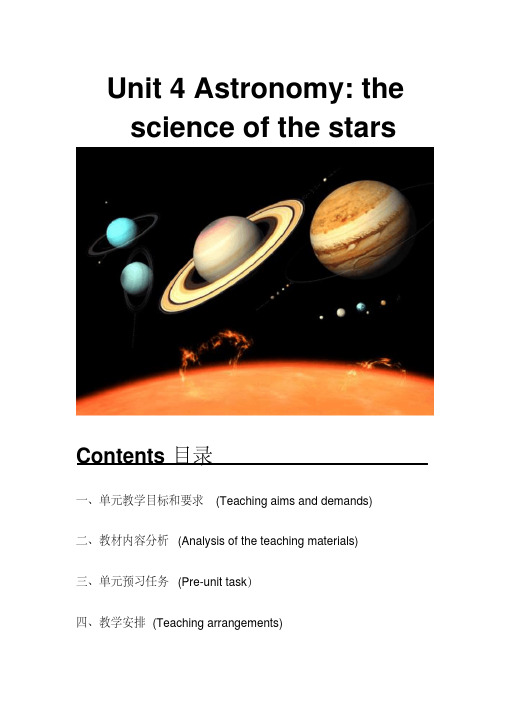
Unit 4 Astronomy: thescience of the starsContents 目录一、单元教学目标和要求(Teaching aims and demands)二、教材内容分析(Analysis of the teaching materials)三、单元预习任务(Pre-unit task)四、教学安排(Teaching arrangements)五、教学步骤(Teaching procedures)六、背景参考资料(Background knowledge)七、评价与反思(Assessment and reflection)一、教学目标和要求(Teaching aims and demands)根据《英语新课程标准》(实验稿)关于总目标的具体描述,结合高一学生实际和教材内容,我们将教学目标分为语言知识、语言技能、学习策略、情感态度、文化意识五个方面。
1.语言知识(Knowledge)词汇(Vocabulary):能理解、内化、运用以下生词--atmosphere, violent--violence, solid, explode, oxygen, surface, planet, harmful—harm, development—develop, spread, method, presence, telescope, disappointed, force, gradually, float, mass,短语(Phrases and expressions):the solar system, in time, carbon dioxide, prevent… from, depend on, cheer up, now that, break out,功能(Functions):学习掌握一些用于陈述问题及给予意见的结构,如:My problem/ trouble is……? The difficulty / question is…My advice/ suggestion is…What I think about it is…Please pay attention to…Make sure you …Watch out for…语法(Grammar):掌握和运用主语从句。
第三册第四单元复习教案(人教版必修) 教案教学设计共3篇
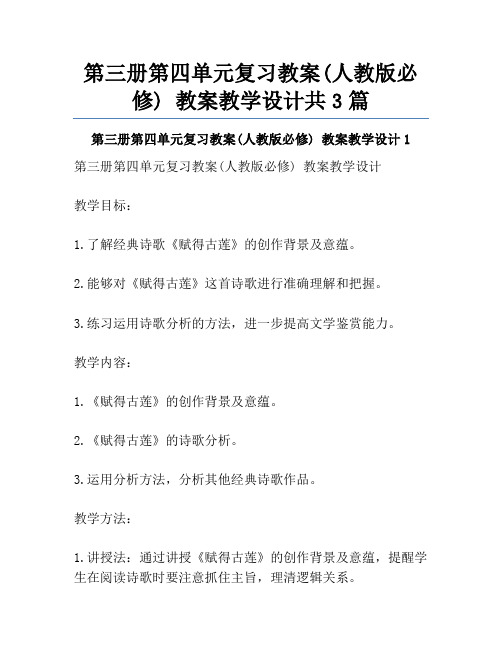
第三册第四单元复习教案(人教版必修) 教案教学设计共3篇第三册第四单元复习教案(人教版必修) 教案教学设计1第三册第四单元复习教案(人教版必修) 教案教学设计教学目标:1.了解经典诗歌《赋得古莲》的创作背景及意蕴。
2.能够对《赋得古莲》这首诗歌进行准确理解和把握。
3.练习运用诗歌分析的方法,进一步提高文学鉴赏能力。
教学内容:1.《赋得古莲》的创作背景及意蕴。
2.《赋得古莲》的诗歌分析。
3.运用分析方法,分析其他经典诗歌作品。
教学方法:1.讲授法:通过讲授《赋得古莲》的创作背景及意蕴,提醒学生在阅读诗歌时要注意抓住主旨,理清逻辑关系。
2.互动讨论法:通过开展小组讨论、学生自主讨论等互动交流方式,让学生对诗歌进行深入剖析和探究。
3.对比分析法:利用对比分析的方法,让学生对比各种诗歌作品的风格和特点,进一步提高其文学鉴赏能力。
教学过程:一、导入环节教师介绍《赋得古莲》的背景,引导学生体会这首诗歌所表达的情感。
二、学习环节1.学生自主阅读《赋得古莲》,并交流各自的理解和感受。
2.教师对《赋得古莲》的具体表现形式、文学艺术手法等进行分析讲解,使学生能够准确理解该诗歌的意蕴。
3.开展分组讨论,让学生自由讨论其他经典诗歌作品,提高学生对文学作品的理解能力。
三、总结环节回顾本节课的教学内容,并提醒学生在平时的学习中重视对经典文学作品的阅读和分析。
四、作业布置1.要求学生在家读更多的经典文学作品,进一步提高其文学鉴赏能力。
2.要求学生写一篇关于自己最喜欢的诗歌作品的读后感,可以结合自己的感受及理解进行写作。
教学反思:本堂课通过多种教学方法,如讲授法、互动讨论法、对比分析法等,使学生对《赋得古莲》这首经典诗歌有了更深入的理解和认识,提高了其对诗歌分析的能力和文学鉴赏能力。
同时,本节课还通过让学生自主性讨论和交流,增强了学生的互动交流和合作精神,促进了学生的全面发展通过对比分析不同诗歌作品的风格和特点,可以进一步提高学生的文学鉴赏能力,让他们更好地理解和欣赏诗歌艺术。
人教版英语必修三Unit 4(Reading)教案(反思)

How Life Began on The Earth教学内容:人教版高中英语必修3第四单元阅读Ⅰ. Teaching important and difficult points:1. Enable the Ss to master the main idea of the text.2. Get the Ss to understand how to finish the exercises of the text.Ⅱ. Teaching aims:Knowledge aims:1. Let the Ss master the key words.2. Lead Ss to learn the usage of useful sentence structures.Ability aim:Develop the Ss’reading ability and let them use some reading strategies such as skimming, scanning, and so on.Emotional aims:1. Enable the Ss to understand how life began on the earth.2. Get the Ss to be aware of the importance of protecting our earth.渗透法制教育: 在上课过程中给学生渗透与《中华人民共和国环境保护法》相关的内容。
Ⅲ. Teaching methods:Task-based teachingDiscussionCooperative learningⅣ. Teaching procedureStep 1 LeadingUse a short film to lead the Ss to understand the origin of life on the earth.Step 2 Pre-readingAccording to the development of life, let the Ss divide the text into several parts, then ask them to finish the following questions.1. How many parts are there in the passage?2. What dose each part mainly talk about?Step 3 While-reading1. How many steps are there before the earth formed?2. How many steps are there during the development of life?3. Read the whole text and fill the following blanks.Nobody knows how the earth , however, there are a widely accepted , the universe began with a which threw matter in all directions. At that time, the earth was still a cloud of ,after that, the earth had become with its atmosphere, which formed with dioxide, nitrogen and so on. And thenalso appeared on the earth, which was fundamental to development of life.After many millions of years, the first extremely small began to appear, later the early and all sorts of fish also appeared in the water. And then different plants and animalson land. Later the huge animals, called , appeared.Finally some clever animals with and feet appeared, they become the most important animals on the . However, they may let the earth become too to live on.4. Finish the following exercises according to the whole text.(1) why was life able to develop on the earth but not on other planet?A. The earth had a solid shapeB. The earth did not have harmful gases in its atmosphere.C. The water stayed on the earth but not on other planets.D. The earth was not too hot.(2) why was it necessary for plants to grow before animals?A. Animals needed plants to protect them from the sun.B. Plants provided oxygen for animals to breath.C. Animals could hide from hunters in the forest.D. It was easier for plants to grow.(3) what is the correct order according to the text?①The clever animals with hands and feet appeared andspread to grow.②The “Big Bang”.③Small plants began to appear on the surface of the water.④65 million years ago of the dinosaurs ended.A. 2 1 3 4B. 4 3 1 2C. 2 4 3 1D. 2 3 4 1(4)What is the main idea of the text?A. The formation of the earth.B. The humans let the earth become too hot to live on.C. The development of dinosaurs.D. The origin of life on the earth.Step 4 Post -readingRead the text and do the true-or-false questions.(1) Human beings have known the origin of the earth clearly so far. ( )(2) the appearance of water made it possible for plants and animals to live on the earth.( )(3) Plants first appeared on land and then in the water.( )(4) Dinosaurs existed on the earth for over 140 thousand years. ( )(5) It is human beings that are not looking after the earth very well and have caused global warming.( )Step 5 Summary1. How the earth formed .2. The development of life on the earth.3. The earth needs us to take care of it.Step 6 Homework1. Please retell the passage in your own words.2. Finish the exercises in your books.教学反思:本堂课总体达到了预期的教学效果,有不少亮点,但是其中也有许多的不足。
高中语文必修三第四单元教学设计 (人教版高一必修三)
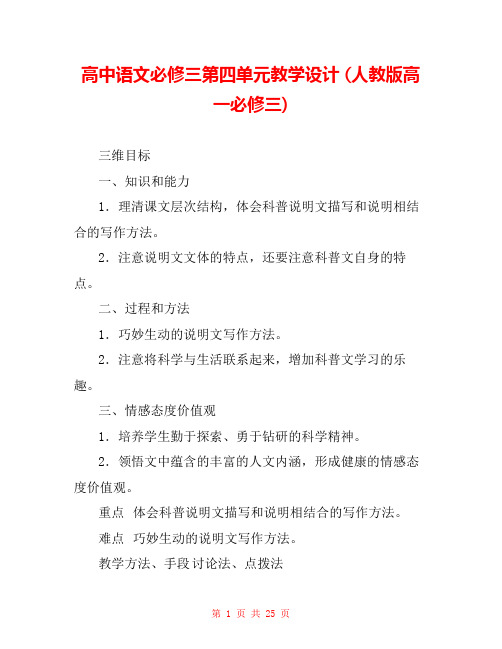
高中语文必修三第四单元教学设计 (人教版高一必修三)三维目标一、知识和能力1.理清课文层次结构,体会科普说明文描写和说明相结合的写作方法。
2.注意说明文文体的特点,还要注意科普文自身的特点。
二、过程和方法1.巧妙生动的说明文写作方法。
2.注意将科学与生活联系起来,增加科普文学习的乐趣。
三、情感态度价值观1.培养学生勤于探索、勇于钻研的科学精神。
2.领悟文中蕴含的丰富的人文内涵,形成健康的情感态度价值观。
重点体会科普说明文描写和说明相结合的写作方法。
难点巧妙生动的说明文写作方法。
教学方法、手段讨论法、点拨法课时1课时教学过程教学步骤、内容个性设计一、谈话引入,建构话题黑板上书写“游戏”。
同学们,儿时你玩的游戏有哪些呢?你从中收获了什么呢?大家喜欢游戏吗?为什么那么喜欢游戏呢?(学生齐声回答)看来,游戏让我们的童年充满了快乐,那么,动物呢?他们会游戏吗,它们的童年又是怎样度过的?今天。
就让我们一起走进动物的王国,去探寻动物游戏的秘密。
二、介绍文体特征及科普文的阅读方法学生回忆说明文的有关知识:说明顺序:时间空间逻辑说明文结构:总分式并列式递进式科普说明文:介绍科学领域某方面的探索、研究的文章。
语言准确、全面。
在宣传科普知识的同时,注重激发人们对科学知识的兴趣,培养人们的科学探索精神。
阅读步骤1.略读课文,整体把握:了解信息:从语句,语段中找出事物的特征;明确说明顺序,简析课文结构。
2.品读课文,深入感知:筛选、概括信息:分析文章重点内容,从文章中概括,提炼出事物的特征,掌握说明文所介绍的知识。
分析说明方法,体会语言特征等。
3.深入探究、拓展视野运用、组合信息:探究文中蕴含的科学精神,感受科学思维,培养我们追求真理的思想。
三、初读课文,整体把握1.科学研究的思维过程一般是:提出问题——分析问题——解决问题。
请同学们快速浏览文章,看本篇文章中作者提出了怎样一个问题,从文本中找出。
【明确】动物为什么游戏。
人教版高一英语必修三 unit 4 _教案

教学过程一、课堂导入Play a game to learn the names and positions of the planets:Venus is next to Mercury.Earth is the third planet.Mars is between Earth and Jupiter.Neptune is the furthest planet from the sun.Saturn is between Uranus and Jupiter.Mercury is closest to the sun.二、复习预习教师引导学生复习上节课所学知识点,(以提问、回顾的形式进行),针对上节课的作业进行讲评、订正、答疑,并通过对主语从句具体用法的分析和扩展导入本节课所要学习的课本知识的学习。
三、知识讲解考点/易错点1 重点单词与短语学习violent adj. 暴力的;猛烈的(回归课本P25)The earth became so violent that it was not clear whether the shape would last or not.[归纳拓展]violent criminals: 使用暴力的罪犯a violent attack: 猛烈的攻击a violent protest:强烈的抗议a violent struggle;激烈的斗争violent winds and storms 狂风暴雨violent toothache: 剧烈的牙痛in time 及时;最后(回归课本P25)It exploded loudly with fire and rock. They were in time to produce carbon dioxide,nitrogen water vapor and other gases,which were to make the earth’s atmosphere.它(地球)巨大的爆炸喷出了烈火与岩石,最终产生了水蒸汽、二氧化碳、氧、氮和其他多种气体,从而形成了地球的大气层。
人教版必修三第四单元教案

Unit 4 Astronomy: the science of the starsHow life began on the earth (reading)Teaching Aims:Knowledge aims: 1. To get Ss to know something new words and structures about the astronomy.2. To grasp the idea of the passage ….Ability aims: 1.To dev elop Ss’ basic skills of speaking and reading. Reading is the focus in this lesson. Reading skills for Ss include (predicting, skimming, scanning and digesting.)2.To retell the story according to the time orderEmotional aims: To develop the students’ responsibility to protect the earth.Lesson type:period 1Lesson time: 45 minutesTeaching important points:1. Let ss. learn some related words ,expressions and structures in this part;2. Improve ss. reading skills (predicting, skimming, scanning, guessing difficult words, topic sentences)3. Help ss. understand the development of the creatures according to the time order Teaching difficult points:To retell the development of the creatures according to the time orderTeaching methods: Task-based teaching and Cooperative learningTeaching Aids: a multi-media computer and a blackboardTeaching Procedure:Step 1. Warming-up & lead-inTask 1 (class work)To show some pictures about eight planets on PPT and get the students to match the pictures with their English names.Task 2 (individually)Brain-storm some topics that are about astronomy. If the students can’t think of much, I will list some of them.Task 3 (group work)To offer some questions about astronomy and get the students to choose what they are the mostinterested in to answer. Then tell the ideas to the group members. The following questions are included.1.How did the universe begin?2.How did the life on the earth begin?3.What is the “black whole”?4.Is there life on other planets besides the earth?5.What happened to all the matter after the “Big Bang”?Step 2. Pre-readingTask 1 to tell the story (class work)To show the pictures about that Nvwa ,God and Darwin, and to get the students to answerQ: Can you tell something about the pictures?Task2 predicting (individually)Read the title of the passage and predict what the passage is about.Step 3. While-readingTask 1(individually) Teaching the new words and structuresStudents are encouraged to preview the text and find out the new words and structures. They should try to work out the meaning of the new words through context. If necessary, they can look up in the dictionary or turn to the teacher for help.Task2 skimming (individually)Ss are required to go through the whole passage quickly to get the general idea and pay special attention to the first or last Para of the article (or the first sentence or the last sentence of each Para.)Task 3 scanning (group work)1.When did the “big bang” happen?2.What form was the earth after the “big bang” ?3.How did water come into being on the earth?4.what made up the earth’s atmosphere after the earth exploded?5.what’s the significance of the presence of water on the earth?6.what was important to the development of fish?7.what made possible the rise of mammals on the earth?8.why are mammals different from all life forms in the past?Task 4 careful reading (group work)Encourage Ss to read the passage again. According to the time order, students are encouraged to exchange their understanding of the passage with their group members and work together to fill in the following form:Step 4. Post-readingTask1 retell (pair work)look at the picture on the page of 26 of the text book and retell the procedure of the development of the creatures.Task2 Discussion (Group work)Reread the sentence “The earth may become too hot to live on” a nd discussWhat can we do to protect the earth?Step 5. HomeworkTask1 consolidate the new words and structures they have learned.Task 2 Encourage Ss to go to the school library or get on the Internet if possible to consult related English websites to search for more information about the origin of life on the earth and find out more evidence to support the theory on the internet.Blackboard-design for this period:TitleHere are some new words for SsHere is the form 1 23 5 46 789。
人教版新教材选择性必修第三册Unit4 Reading and Thinking教学设计
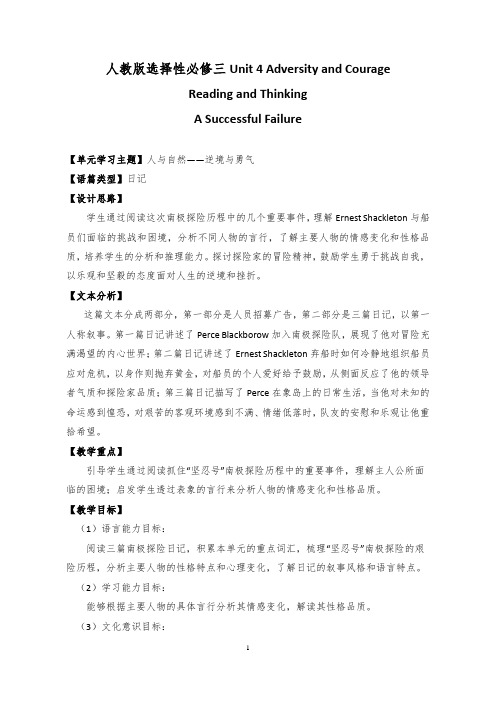
人教版选择性必修三Unit 4 Adversity and CourageReading and ThinkingA Successful Failure【单元学习主题】人与自然——逆境与勇气【语篇类型】日记【设计思路】学生通过阅读这次南极探险历程中的几个重要事件,理解Ernest Shackleton与船员们面临的挑战和困境,分析不同人物的言行,了解主要人物的情感变化和性格品质,培养学生的分析和推理能力。
探讨探险家的冒险精神,鼓励学生勇于挑战自我,以乐观和坚毅的态度面对人生的逆境和挫折。
【文本分析】这篇文本分成两部分,第一部分是人员招募广告,第二部分是三篇日记,以第一人称叙事。
第一篇日记讲述了Perce Blackborow加入南极探险队,展现了他对冒险充满渴望的内心世界;第二篇日记讲述了Ernest Shackleton弃船时如何冷静地组织船员应对危机,以身作则抛弃黄金,对船员的个人爱好给予鼓励,从侧面反应了他的领导者气质和探险家品质;第三篇日记描写了Perce在象岛上的日常生活,当他对未知的命运感到惶恐,对艰苦的客观环境感到不满、情绪低落时,队友的安慰和乐观让他重拾希望。
【教学重点】引导学生通过阅读抓住“坚忍号”南极探险历程中的重要事件,理解主人公所面临的困境;启发学生透过表象的言行来分析人物的情感变化和性格品质。
【教学目标】(1)语言能力目标:阅读三篇南极探险日记,积累本单元的重点词汇,梳理“坚忍号”南极探险的艰险历程,分析主要人物的性格特点和心理变化,了解日记的叙事风格和语言特点。
(2)学习能力目标:能够根据主要人物的具体言行分析其情感变化,解读其性格品质。
(3)文化意识目标:了解南极探险的历史背景、典型人物的故事和探险精神;培养自己坚毅的品质和乐观的人生态度,勇于面对挑战、挫折与逆境。
(4)思维品质目标:能够根据不同角度的叙事整理出“坚忍号”南极探险的大致历程;能够对文本中的细节进行推理分析,判断主要人物的心理状态和性格品质。
人教版英语必修三 Unit 4 教案

人教版英语必修三 Unit 4 教案教学目标1. 了解并掌握本单元的词汇和词组。
2. 能够正确运用所学的语法知识构造符合语境的句子。
3. 了解并理解单元主题,培养学生的阅读理解能力。
4. 提高学生的听说能力,能够用英语进行简单的交流和表达。
教学准备1. 教材:人教版英语必修三 Unit 4。
2. 多媒体设备,如电脑、投影仪等。
3. 教学辅助材料:练题、图片、录音等。
教学内容1. 词汇和词组的研究:通过课堂展示和练,让学生掌握本单元的关键词汇和词组,如"environmental issues"、"pollution"等。
2. 语法知识的讲解:通过示范和练,教授学生本单元的语法知识,如不定式的用法和宾语从句的构造。
3. 阅读理解训练:通过教材中的阅读理解部分,让学生阅读并理解文章内容,培养他们的阅读理解能力。
4. 听说能力的提高:通过听力训练和口语练,提高学生的听说能力,让他们能够用英语进行简单的交流和表达。
5. 综合练:通过综合练题,巩固学生对本单元知识的掌握程度,评估他们的研究效果。
教学步骤1. 导入:通过引入一幅关于环境问题的图片,引起学生的兴趣,并提出问题引发讨论。
2. 词汇研究:呈现本单元的关键词汇和词组,让学生通过图片、例句等进行研究和掌握。
3. 语法知识讲解:通过示范和练,讲解不定式的用法和宾语从句的构造。
4. 阅读理解训练:学生阅读教材中的文章,理解文章内容,并回答相关问题。
5. 听说能力提高:通过听力练和口语练,提高学生的听说能力,让他们能够用英语进行简单的交流和表达。
6. 综合练:布置综合练题,让学生巩固所学知识,并评估他们的研究效果。
7. 小结:对本节课的主要内容进行总结和回顾,强化学生对所学知识的记忆。
教学评价1. 教师观察法:通过观察学生在课堂上的表现和回答问题的能力,评估他们对所学内容的掌握程度。
2. 练题评价法:通过布置练题,收集学生的答题情况,评估他们的研究效果。
人教高中英语必修三第四单元-教学设计
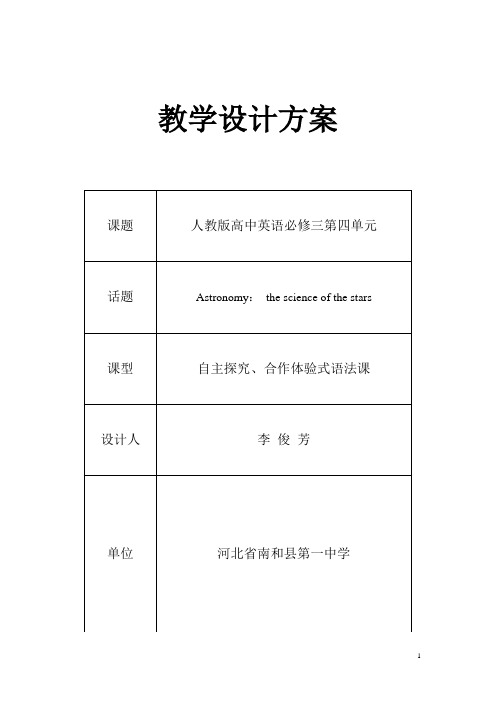
本节内容是语法学习,旨在通过本节语法载体,激励学生体验英语学习之乐,引导学生形成语法学习策略、提高学习能力和语言运用能力。
学 情 分 析
1.学情了解:通过学生访谈和预习观察,了解到学生对语法学习方式有初步认识,但对语法运用和体验还需加强,英语运用能力尚待进一步培养。
2.学生认知发展分析:学生经过半年的高中英语学习,已经初步适应了高中教材,初步形成一些英语思维能力和学习能力,英语运用能力初步形成,但还薄弱,而且对于主语从句的概念和运用还陌生,需要进一步培养。本节课旨在通过该项语法学习,对学生的学习策略进一步引导,继续培养学生的自主探究能力,为学生终身学习能力的培养打下结实的基础.
To encourage students to apply grammar knowledge and experience joy from learning English。
激励学生体验英语语法学习之乐,培养英语语法学习策略
Step6
Summary and assessment(5m)
环节6
总结评价
火眼金睛
发现破绽
Inspire and instruct students to find out the mistakes in the sentences.
激励学生找出句子中的错误
Find out the mistakes using the knowledge learned in the class。
教学设计方案
课题
人教版高中英语必修三第四单元
话题
Astronomy:the science of the stars
课型
自主探究、合作体验式语法课
设计人
2019-2020学年高中英语人教版必修三Unit4全单元教案
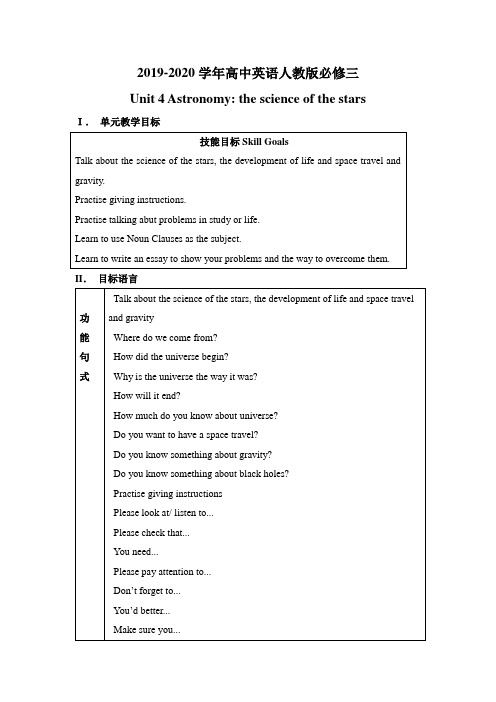
2019-2020学年高中英语人教版必修三Unit 4 Astronomy: the science of the stars I.单元教学目标II.目标语言III.教材分析与教材重组1. 教材分析本单元以astronomy: the science of the stars, the development of life, space travel and gravity为话题,通过本单元的几篇阅读材料使学生对以上问题有所了解,并通过文章中的一些探讨性的问题,比如,The earth may become too hot for the lives on it. Then what will our future be? 使学生更好地了解我们的地球和我们的生活环境,并引发对“地球的将来如何”的热烈讨论,通过这些讨论激发学生对天文学了解和探究的强烈兴趣。
通过讨论登月球需要的物品和可能遇到的困难学会提出问题和解决问题的表达方法,并能就此写出一篇表达合理思路清晰的短文。
1.1 WARMING UP以讨论的形式通过三组问题引导学生讨论边缘科学,讨论科学的方法以及要成为真正的科学家所必须掌握的技能。
1.2 PRE-READING 主要让学生弄清楚什么是科学思想,什么是宗教信仰或文化传统。
在探讨生命起源的科学道理之前,让学生以听故事或讲故事的方式,交流有关宇宙的起源的种种传说,既有趣味性,又能调动学生的相关知识,激活学生的思维。
1.3 READING 讲述了地球上生命的起源。
水的形成使得地球有别于其他星球,它使得地球上生命的诞生成为可能。
科学家认为,地球上的生命首先诞生于水中,上百万年后,陆地上才长出绿色植物,随后出现了陆栖动物和水陆两栖动物。
最初的动物靠孵化繁衍后代,后来出现了哺乳动物,人类也随之诞生了。
文章最后讲了令人深省的问题:The earth may become too hot for the lives on it.1.4 COMPREHENDING通过四个选择填空题检测学生对本文核心问题的理解:地球上生命的起源和延续需要哪些条件?随后通过排序的方式帮助学生弄清本文的行文线索,也就是地球上生命的起源和发展历程。
新人教版必修三Unit 4 Listening and Speaking教案
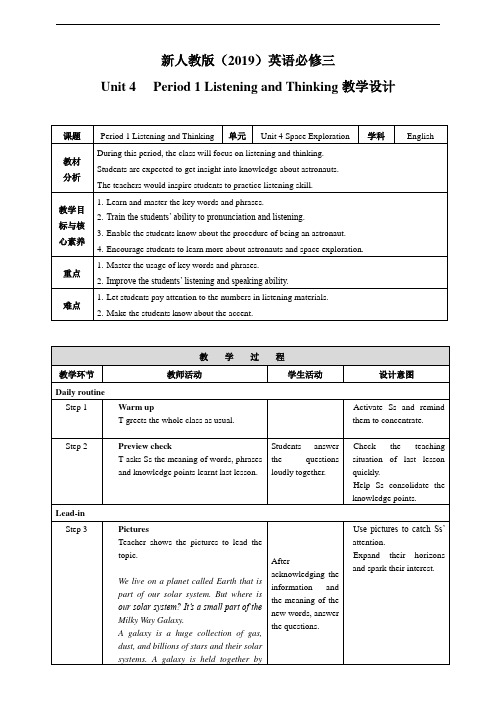
3.Enable the students know about the procedure of being an astronaut.
4.Encourage students to learn more about astronauts and space exploration.
Students are expected to get insight into knowledge about astronauts.
The teachers would inspire students to practice listening skill.
教学目标与核心素养
1.Learn and master the key words and phrases.
-He is 1 meter 80 centimeters tall.
-A rocket was fired at the moon.
-The force of gravity makes things fall to earth.
-Teach the meaning of new words.
Step 5
3.Mr. Yang was selected to attend pilot training with 13 other people.
4.To become an astronaut in China, you have to have 1350 hour of flying experience.
5.Astronauts not only had to learn how to use space equipment, but also had to do a lot of mental and physical training.
人教版高中英语必修3 第4单元grammar---教学设计

Teaching plan 必修3 第4单元Analysis of teaching materialThis is the 3rd teaching period of this unit. We mainly deal with the grammar: Noun clauses as the subject. Students often feel this item abstract and difficult, so it is necessary to make the lesson interesting and connect it with their daily life.Objectives1. Knowledge objects:a) The students will be able to recognize the subject clause.b) The students will be able to master the connectors in the subject clause.c) The students will be able to use subject clauses in their expressions correctly andproperly.Ability objects:(1)To develop the students ' abilities of doing exercises and writing.(2)To train the students 'ability of working in pairs.(3)To enhance students ' ability of grammar learning.3. Emotion or moral objects:By completing the task, the students can increase their interest and set up self-confidence in grammar learning.Teaching focus and difficultyTeaching focusGet students to learn and master the new grammar: subject clause.Teaching difficulty* Enable students to make up their own sentences with subject clause.1* Help students how to cooperate and work with each other.Teaching proceduresStep1 Lead inListen to an English song and complete the lyrics.Although loneliness has always been a friend of mineI'm leaving my life in your handsPeople say ①I'm crazy and that I am blindRisking it all in a glance②How you got me blind is still a mysteryI can't get you out of my headDon't care ③what is written in you historyAs long as you're here with meI don't care ④who you are,where you're from,wha t you didAs long as you love meWho you areWhere you're fromDon't care ⑤what you didAs long as you love meEvery little thing that you have said and doneFeels like it's deep within meDoesn’t really matter if you're on the runIt seems like(as if)⑥ we're meant to beask students to find out the Object clauses and Predicative clauseObject clauses _________________________Predicative clauses _____________________I am a teacher.The book is funny.Seeing is believingThe cause is still a mysteryHow you got me blind is still a mystery(谜)Ask the students to observe the given sentences, and then introduce the definition of the subject clause.This activity is designed to arouse the students’ interest and review what they have learnt in unit 3 about grammar.Step2.Learn subjective clauses1 )Pick out subject clausesHow you got me blind is still a mystery.That she had won the first prize made the girl very happy.What he said is not true.What they need is a dictionary.2) pick out the subject clauses in the reading text1.What it was to become was uncertain until between 4.5 and 3.8 billion years ago.2.What is even more important is that as the earth cooled down, water began to appear on itssurface.3.What many scientists believe is that the continued presence of water allowed the earth todissolve harmful gases and acids into the oceans and seas.4.Why they suddenly disappeared still remains a mystery.5.So whether life will continue on the earth for millions of years to come will depend onwhether this problem will be solved.This activity is designed to ask the students to consolidate the feature of the subject clause. Step3 Learn about the connectors.Who will go makes no difference.Which is the best is not certain.Why dinosaurs died out is still unknown.When we will get together has not been decided.How she can keep healthy is a secret. Whether he will come is not very important.That he was late again made me angry.Where they will go is unknown.That she missed the chance is really a pity.Get the students to sum up the connectors in the given sentences.what, who, which ,when, where, why, how ,that , whetherThis activity is designed to make the students learn about the usage of the connectors. Step 4 Learn and Practice1) Ask the students to fill in the blanks:1___________ is needed for the space trip is careful preparation.2.___________ wild life can be well protected is very important.3._____________ will go makes no difference.4._____________ dinosaurs died out remains a puzzle.5. It hasn’t been decided yet ______________ the restaurant will open.6.___________ he will join us or not won’t really matter.7 .____________ is troubling me is that I can’t follow him.8.It is a pity _________ you have to leave now.9.____________ the meeting will be held next week hasn’t been decided yet.10.____________ ream will win the match is still unknown.2.) Make some sentences using subject clauses according to the pictures.1)Which star he come unknownWhich star he came from is unknown.2) what make Kimi happy drink milkWhat makes Kimi happy is to drink milk.3)it, report , the final competition, hold ,this Friday night.It is reported that the final competition will be held this Friday night. 4) what shock us the Malaysian disasterWhat shocked us is the Malaysian disaster5)it obvious Mr.Zeng confidentIt is obvious that Mr. Zeng is confidentThis activity is designed to make the students use the conjunctional words and the subject clausesStep 5 Learn and UseCompare the following passages and then complete the passage B according to the Chinese sentences.ASomeone has told us that we will have an English party next week. But we don’t know when we will hold the party and where we will hold it. Li Sha said that it isn’t important who will be the host. Yang fang said that our monitor is the right person for it, but he will be out on business next week.B____________________________(我们已经被告知)there is going to be an English party next week, but we don’t know the exact time and place. “I tmakes no difference ______________________________________________________(我们将在什么时候,什么地方举行这次聚会), but it matters a lot___________________________(谁将主持这次聚会).Do you think so?” said Li Sha. Hearing ________________________________(她所说的), Yang Fang said our monitor is right person for it, but the question is ________________________________________________(他将外出出差) at the same time.This activity is design to help the students can use the noun clauses in writing. Step 6 Sum upStep7 HomeworkWrite a self-introduction using more noun clauses.Blackboard design.Unit5 AstronomySubject ClauseConnectors:that whetherwhat which who whom when why where how It is said that…It is reported that…It is adj that…。
人教版高中英语必修三教案:unit4+Reading+How+life+began+on+the+earth.doc
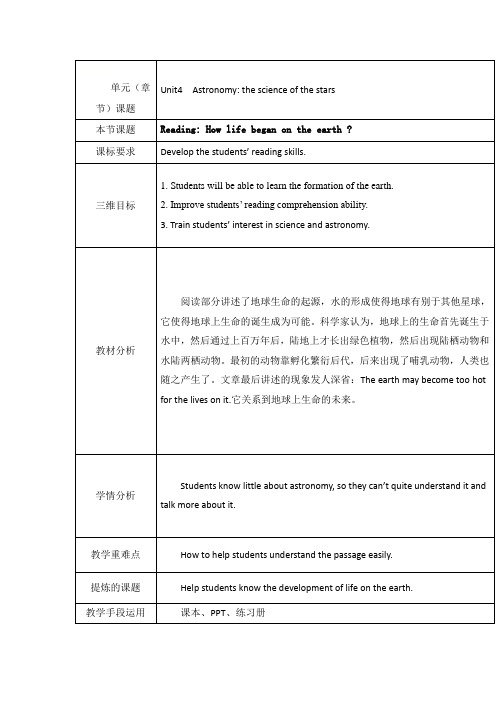
单元(章精美句子1、善思则能“从无字句处读书”。
读沙漠,读出了它坦荡豪放的胸怀;读太阳,读出了它普照万物的无私;读春雨,读出了它润物无声的柔情。
读大海,读出了它气势磅礴的豪情。
读石灰,读出了它粉身碎骨不变色的清白。
2、幸福幸福是“临行密密缝,意恐迟迟归”的牵挂;幸福是“春种一粒粟,秋收千颗子”的收获. 幸福是“采菊东篱下,悠然见南山”的闲适;幸福是“奇闻共欣赏,疑义相与析”的愉悦。
幸福是“随风潜入夜,润物细无声”的奉献;幸福是“夜来风雨声,花落知多少”的恬淡。
幸福是“零落成泥碾作尘,只有香如故”的圣洁。
幸福是“壮志饥餐胡虏肉,笑谈渴饮匈奴血”的豪壮。
幸福是“先天下之忧而忧,后天下之乐而乐”的胸怀。
幸福是“人生自古谁无死,留取丹心照汗青”的气节。
3、大自然的语言丰富多彩:从秋叶的飘零中,我们读出了季节的变换;从归雁的行列中,我读出了集体的力量;从冰雪的消融中,我们读出了春天的脚步;从穿石的滴水中,我们读出了坚持的可贵;从蜂蜜的浓香中,我们读出了勤劳的甜美。
4、成功与失败种子,如果害怕埋没,那它永远不能发芽。
鲜花,如果害怕凋谢,那它永远不能开放。
矿石,如果害怕焚烧(熔炉),那它永远不能成钢(炼成金子)。
蜡烛,如果害怕熄灭(燃烧),那它永远不能发光。
航船,如果害怕风浪,那它永远不能到达彼岸。
5、墙角的花,当你孤芳自赏时,天地便小了。
井底的蛙,当你自我欢唱时,视野便窄了。
笼中的鸟,当你安于供养时,自由便没了。
山中的石!当你背靠群峰时,意志就坚了。
水中的萍!当你随波逐流后,根基就没了。
空中的鸟!当你展翅蓝天中,宇宙就大了。
空中的雁!当你离开队伍时,危险就大了。
地下的煤!你燃烧自己后,贡献就大了6、朋友是什么?朋友是快乐日子里的一把吉它,尽情地为你弹奏生活的愉悦;朋友是忧伤日子里的一股春风,轻轻地为你拂去心中的愁云。
朋友是成功道路上的一位良师,热情的将你引向阳光的地带;朋友是失败苦闷中的一盏明灯,默默地为你驱赶心灵的阴霾。
- 1、下载文档前请自行甄别文档内容的完整性,平台不提供额外的编辑、内容补充、找答案等附加服务。
- 2、"仅部分预览"的文档,不可在线预览部分如存在完整性等问题,可反馈申请退款(可完整预览的文档不适用该条件!)。
- 3、如文档侵犯您的权益,请联系客服反馈,我们会尽快为您处理(人工客服工作时间:9:00-18:30)。
教学目标:
1、复习说明文的文体常识,了解并掌握科普说明文的相关知识。
2、了解并概括文章的大致内容,理清课文的层次结构。
3、学会品味说明文的语言。
4、深入了解文章的主要内容,辨析各种"假说"的区别。
5、培养学生勤于探索,勇于钻研的科学精神.
形式上 总---------分----------总
(几分钟后,学生回答,教师板书提纲)
四、合作探究
(一)、完成课后练习一
引导:现在我们知道动物为什么会游戏?主要内容就在第二部分,现在阅读第二部分,分组讨论,你们认同哪种"假说"?并说出依据,结论,认同度。(课后练习一填写完)
方法策略:学生自主讨论交流并分组回答,小组间进行评价,教师做总评。
三、通读全文,整体感知,把握层次。
学生自读,划分课文层次,学生交流,师生共同评价。
1、弄清各段落之间的内在联系。
2、ห้องสมุดไป่ตู้据分析,列出提纲。
3、由学生讨论后明确其内在联系。
明确:科学研究的思维过程一般是 提出问题-------分析问题--------解决问题。课文就遵循了这样的思路安排结构。
内容上,先提出动物的各种游戏行为,引发读者的思考:动物为什么要进行游戏?然后分述各种假说,提供给读者对比思考。最后总结:有待更深入的研究。
教学重点:
1、把握文章思路,理清层次结构.
2、品味本文的语言特点.
教学难点:
描写与说明相结合的语言特点.
课时安排:
1课时
教学过程:
一、导入
黑板上书写 “游戏”,同学们小时候都很喜欢玩游戏,其实,长大了我们还是很喜欢玩游戏,为什么我们那么喜欢游戏呢?
人类会游戏,一度曾认为只有人类才是有智慧的生命体,而其他动物不过是受制于条件反射、具有生理反应的简单生命。现在动物学家们注意到了动物游戏的天性,对动物游戏进行研究,《动物游戏之谜》即是研究结果的展示。
词汇积累:推敲锤炼 词语搭配 感情色彩
修辞方法:比喻 拟人 夸张 反问 排比
六、课堂小结:
本文是一篇通俗易懂的科普说明文,记叙、描写、说明浑然一体,语言简洁、平实、准确、全面,浅显易懂,使人获得科学知识的同时,还能得到某种思想感情的陶冶和艺术上的享受。
学习了这篇文章之后,我们应该重新审视动物,审视自己,更重要的是让我们真正懂得,地球不是人类独有的,动物一样是地球的主人。
①生物的游戏行为是很复杂的,不同的动物可能有不同的原因,同时人类对动物的研究还不够,所以仍是一个谜。
②科学就应该注重实事求是,假说永远是假说,不能贸然下结论。
③就应该提出各种各样的看法,来引起争鸣,真理总是越辨越明。
五、感受本文语言特点,并找出特殊例句。(例略)
1、充满趣味,生动形象
2、准确全面
拓展延伸,联系到写作:说明文恰当运用描写要做到
人教版必修三第四单元教案
教学园地
10-10 1952
:
人教版必修三第四单元教案
马鞍山二十二中高一备课组
《动物游戏之谜》
教学设想:
本课是一篇典型的科普说明文,内容学生还比较感兴趣。课堂如能精心设计几个问题,引起学生探讨的兴趣,将抽象变具体、将乏味变生动,充分发挥学生的主体性、主动性,用心感悟,用自己的观点判断,用自己的思维去创新,用自己的语言去表达,将生活与科学相结合,那么,他们就自然而然的领悟了“动物游戏”的内涵,启迪心智,同时也培养了学生勤于探索、勇于钻研的科学精神。
本文采用何种说明结构方式?又用了何种说明顺序?只有简要的概括出每一段的内容,并弄清各段落之间的内在联系,我们才能得出答案!
请同学们快速阅读课文。(学生速读课文,教师提示说明文阅读程序)
板书:阅读科普说明文的程序
1、整体把握,微观勾勒(关键句 中心句 要点句 过渡句)
2、准确寻找,筛选提取
3、识别混淆,把握内容要点。
课文里的几幅图片展示的就是动物游戏时的可爱画面,那么它们为什么会游戏?游戏的目的又是什么呢?今天我们来共同学习《动物游戏之谜》看看文章告诉了我们哪些?
(板书:动物游戏之谜)
二、推进新课
任何一篇文章的学习,都是从了解课文内容入手,如何快速理解一篇说明文的内容?
并提问学生其他有关说明文的知识,教师点拨。
漫长的两千多年,眼泪、创痛和牺牲终于换来了宝贵的自由。
公元1143年,一个独立的君主制国家葡萄牙,在光复领土的战争中应运而生,并且得到了罗马教皇的承认,这是欧洲大陆上出现的第一个统一的民族国家。
同学们,请你们分析一下这段文字应该是属于什么体裁?
动物游戏之谜
1、结构提纲
叶猴
渡鸭 动物的各种游戏行为 提出问题
露脊鲸
单独游戏
战斗游戏 动物游戏的
操纵游戏
演习说
自娱说 动物游戏的各种假说 分析问题
学习说
锻炼说
总结: 有待更深入的研究 解决问题
2、语言特点:准确全面 充满趣味
《宇宙的边疆》教案
【学习目标】
1、引导学生联系实际,了解解说词的特点。
2、引导学生了解一些有关宇宙的基础知识。
3、引导学生借助文中精辟的议论和热烈的情感抒发,了解对宇宙和人类的思考,并引发自己的思考。
【学习重难点】同目标1、3
【课时安排】1课时
【教学步骤】
一、导入
请看下面这段文字:
征服是从被征服开始的。从公元前11世纪到公元11世纪的两千多年中,伊比利亚半岛上战火连绵不断,这块土地曾先后被罗马人、日耳曼人和摩尔人征服。正如一个个奋不顾身的斗牛士,生活在这块土地上的人们一刻也没有停止同入侵者的抗争,直到今天,我们依然可以清晰地感受到那种仿佛根植于基因中的追求刺激、喜欢冒险的豪情。
此项根据学生自主认识
假说 根据 结论 你的认同度
例:自娱说 河马玩浮叶,渡鸦滑雪梯
通过自得其乐的游戏,使动物紧张的自然竞争生活得到某种调剂和补偿,使它们在生理上、心理上容易保持平衡,从而得到一定的自我安抚,自我保护。
(二)引导:同学们都陈述了自己的见解,那么有没有给我们呈现一个确定的结论呢?
明确:没有,为什么?(找学生回答并出示结论)
“让我们和动物和谐相处,共同迈向美好的明天。”
七、布置作业
1、将有关文体知识内容制作成卡片保存。
2、最近,我们马鞍山市正在进行“四城同创”宣传标语的征集,请你拟写两条“爱护环境保护动物”标语。
3、关于人类从事体育活动、艺术活动的目的,现在有种种理论,莫衷一是。请搜集资料,看看专家们是怎么说的。
板书设计
